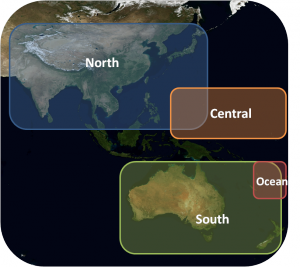This week we’ll continue our look at the climate summaries for each GLOBE region, with a focus on the Asia-Pacific region. Recall that these annual reports provide a summary of the global climatic conditions and are a great benchmark for monitoring climate.
Regional reports provide a tremendous amount of information. The temperature and precipitation climate summaries are highlighted here, but if you are interested, more information about the Asia-Pacific Region state of the climate is available from this website: http://www1.ncdc.noaa.gov/pub/data/cmb/bams-sotc/2010/bams-sotc-2010-chapter7-regional-climates-lo-rez.pdf
Unlike the Africa region, Asia-Pacific requires a breakdown of the region to explain temperature, as well as precipitation for 2010. The GLOBE Asia-Pacific region is the combination of two NOAA climate regions: Asia and Oceania. However, within these two regions that NOAA describes, it was easy to examine the GLOBE Asia-Pacific region.
While we explained in last week’s post why temperature across Africa is much easier to describe than precipitation, with the wide variety of locations in the Asia-Pacific region, it is important to take a look at each separately. The Asia-Pacific region takes into account land-locked countries, such as Mongolia, as well as island countries, like New Zealand. So in order to better describe the Asia-Pacific region, it is broken down into four sectors: north, central, south, and ocean, as shown in the figure below:
Temperature
The north sector includes the GLOBE countries of: Bangladesh, India, Japan, South Korea, Maldives, Mongolia, Nepal, Philippines, Sri Lanka, and Thailand.
Most of this sector saw above average temperatures for 2010, with the exception of South Korea. For Japan, 2010 was the fourth warmest since 1989, with temperatures averaging approximately 0.86 degrees Celsius above average. In India, 2010 was the warmest on record since records began in 1901. Even with the warmest year being set, northern India saw a devastating cold snap during January and February. However, by May, India was seeing heat waves.
The central sector includes the GLOBE countries of: Micronesia, Palau, and Marshall Islands.
Temperatures in this sector were variable, due to the change from El Niño to La Niña. This means that during the first half of the year, temperatures were above normal, while in the second half of the year, temperatures were near normal or slightly below.
The ocean sector includes the GLOBE country of: Fiji.
Temperatures in Fiji were different from the other sectors in the Asia-Pacific region, because they were below average for 2010. Fiji saw an average 0.5 degrees Celsius below normal for the year.
The south sector includes the GLOBE countries of: Australia and New Zealand.
In Australia, 2010 was the coolest year since 2001, but was still warmer than the 1961-1990 average by 0.19 degrees Celsius. In New Zealand, annual temperatures ranged from 0.5 to 1.2 degrees Celsius above average. More specifically, 2010 was the fifth warmest year since 1900, based on a series of seven stations. A number of heat waves were recorded in New Zealand during 2010 in March, November, and December.
Precipitation
In the north sector, most locations saw above average rainfall. The major exception to this was central and northeastern India and Bangladesh. Sri Lanka saw a reverse in their precipitation patterns, as they started out dry for the first half of the year, then saw above average precipitation in the second half of the year.
In the central sector, again the change from El Niño to La Niña caused shifts in patterns, and precipitation was below normal for the first half of the year, and above normal for the second half. On a positive note, this transition season caused tropical cyclone activity to be at an all time low.
In the ocean sector, the change from El Niño to La Niña was also apparent. Like the central sector, precipitation was below normal for the first half of the year, and above normal for the second half. Tropical cyclone activity was more prominent during early 2010, while only one formed during the end of the year.
In the south sector, Australia saw above average precipitation, so much so that 2010 was the second wettest year on record since 1900. Two major flooding events were recorded during 2010, the first in late February into early March, then again in September. New Zealand generally saw near normal rainfall amounts.
With a region as diverse as the Asia-Pacific region, it is no surprise that the region saw dramatic climatic differences. There is much more detail in the actual report summary: http://www1.ncdc.noaa.gov/pub/data/cmb/bams-sotc/climate-assessment-2010-lo-rez.pdf.
How does your record of GLOBE data for the past year compare to the summary provided here? Were the data similar or different to the NOAA climate summary? What kind of significant events have you had in your local area? Share them with us through the comment option below!
Check back next week when we will take a look at 2010 for the Europe-Eurasia Region.
-jm

